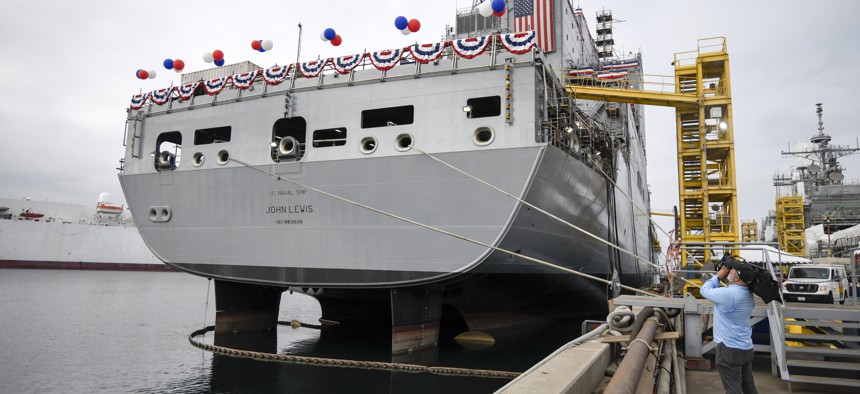
A television cameraman videotapes the USNS John Lewis before a christening ceremony on July 17, 2021, in San Diego. AP / Denis Poroy
US Navy’s Shipbuilding Plan Doesn’t Meet Congress’ Needs, Lawmakers Say
The past few have come with a “check-the-box mentality,” Rep. Wittman said.
The U.S. Navy’s shipbuilding plan doesn’t tell Congress what the service needs, nor does it provide certainty for long-term planning, two House lawmakers say.
“It just didn't start with this 30-year shipbuilding plan,” said Rep. Rob Wittman, R-Va. Tuesday during a panel ahead of the 2021 Sea Air Space conference. “It's been in previous other ones, where they've essentially had a check-the-box mentality…kind of a multiple-choice test. You know this is not multiple choice, this is about making the tough decisions and charting a path to get us to 355” ships. Wittman is the ranking member on the House Armed Services’ subcommittee on seapower and projection forces.
Wittman said the past three shipbuilding plans have not met the needs of Congress, including the most recent one, submitted to Congress in June along with the 2022 budget proposal. It only provided ranges for each ships, such as nine to 11 aircraft carriers, and stated that a complete plan would not be available until the 2023 budget. The 2022 plan does include the eight ships the Navy wants to buy in 2022 but no other details on how total ship numbers change in the decades to come.
That means it lacks the details Congress needs to see into the future for shipbuilding, said Rep. Joe Courtney, D-Conn., the chairman of the seapower and projection forces subcommittee.
“In all honesty, I see it really as the one-year budget plus sort of ranges of ships in the future, which is not, in my opinion, really what the law contemplated,” Courtney said. He was referring to Title 10 U.S. Code 231 which requires a “detailed program” for the construction of combat, support and auxiliary Navy ships over the next 30 years.
The subcommittee’s members and staffs are now having to ask a lot of follow-up questions to the Navy about their decision making behind the plan.
The Navy’s plan does not show Congress how it intends to get to 355 ships, as required by law, nor what the makeup of the fleet will be, the lawmakers said. Nor does it help lawmakers make sure the 355-ship goal stays on track and it causes material purchasing and workforce issues with the shipyards, Wittman said.
“It also sends a signal of ambivalence to our adversaries that says, ‘Well, they're going to kind of build a range of ships, so we're not even certain that they're committed to building the Navy of the future’,” he said.
Wittman said he wanted to see naval strategy drive the budget, and not the other way around, which would mean a complete shipbuilding plan on how to fund at least 355 ships and which ships to build for that fleet.
NEXT STORY: Transfers Alone Won’t Close Guantanamo Bay




